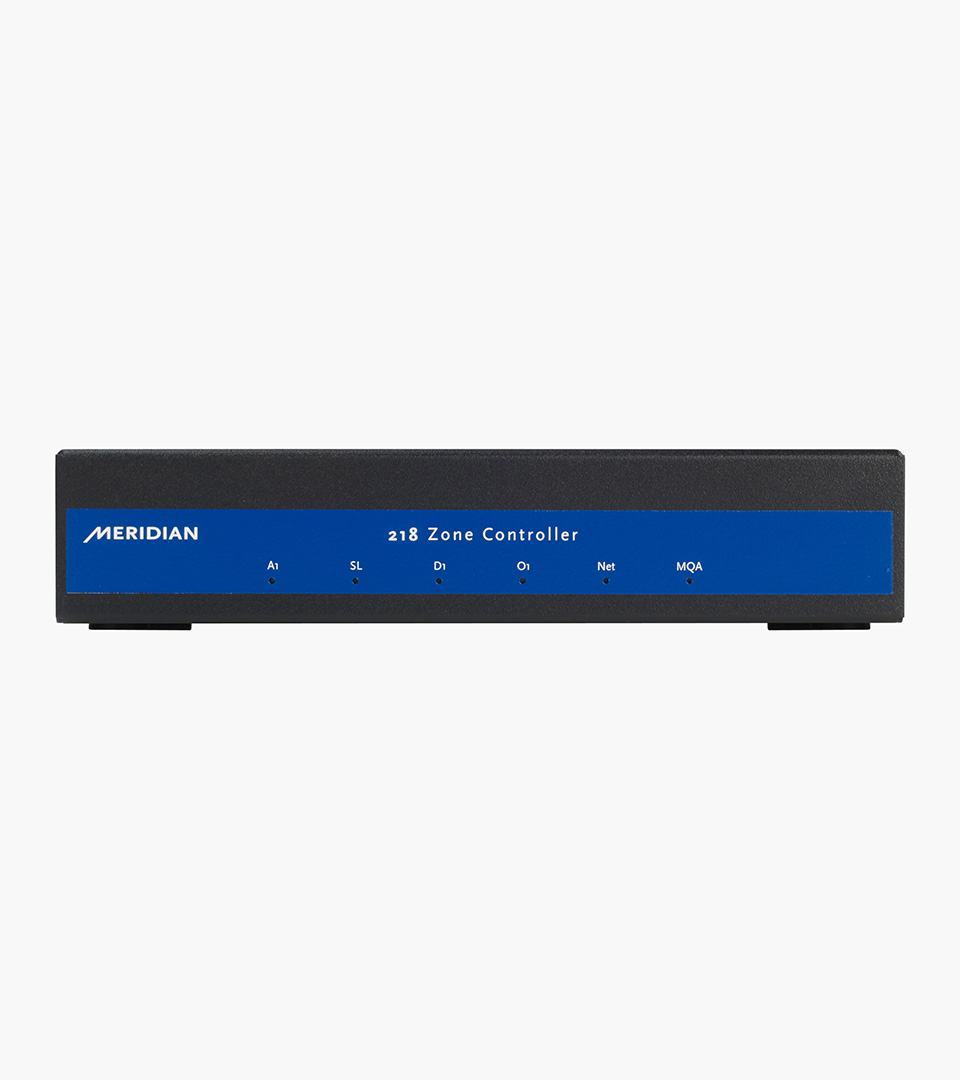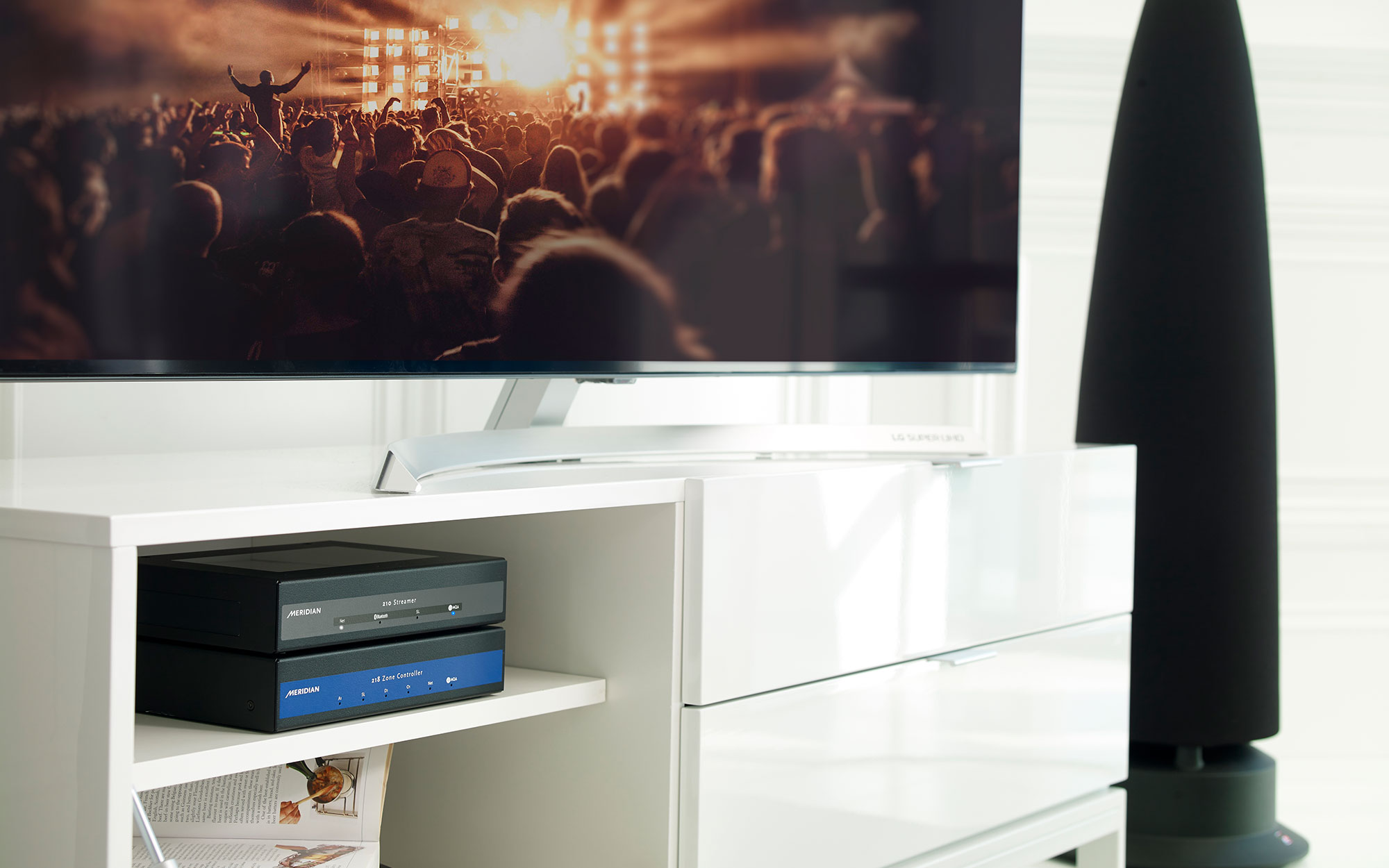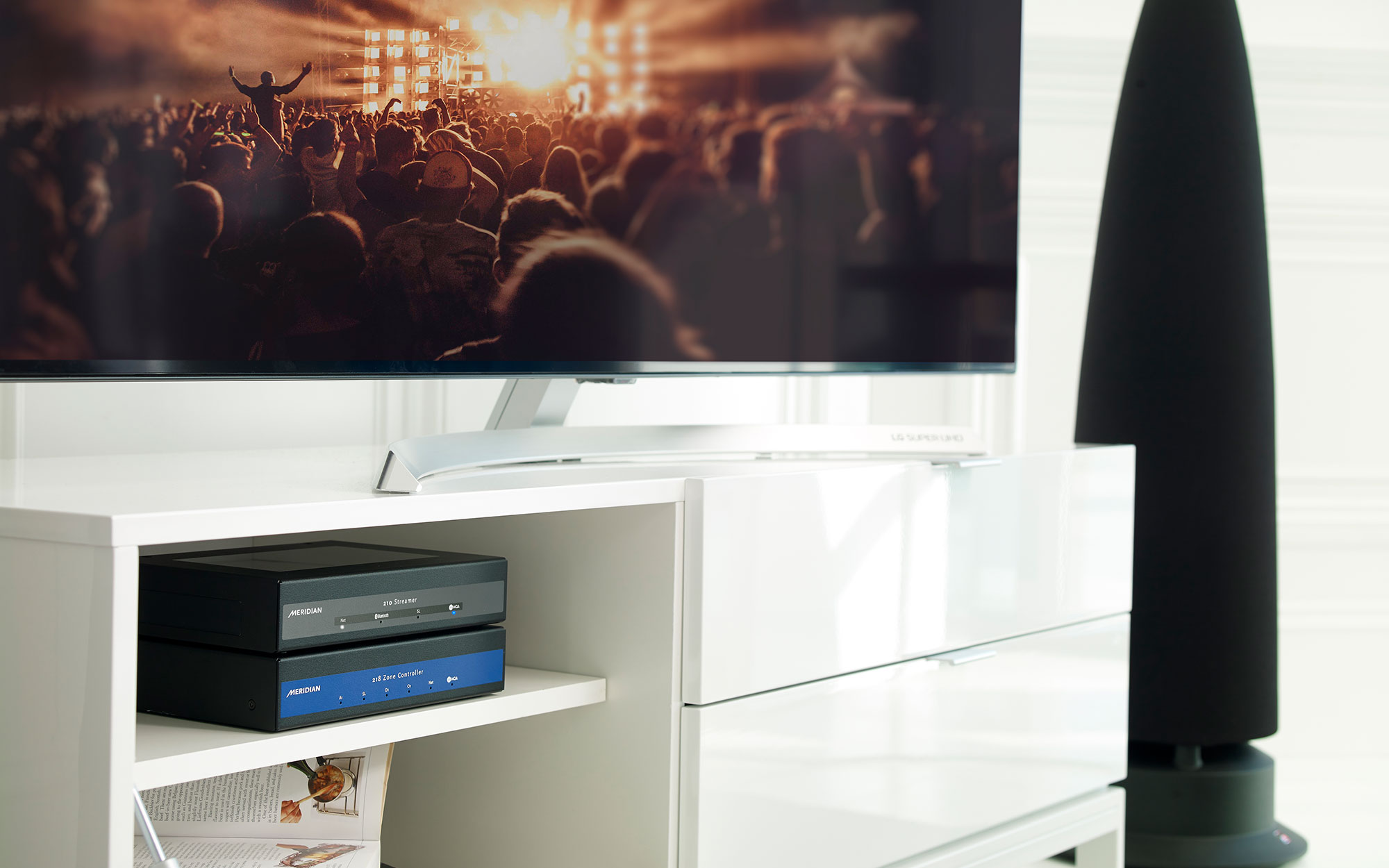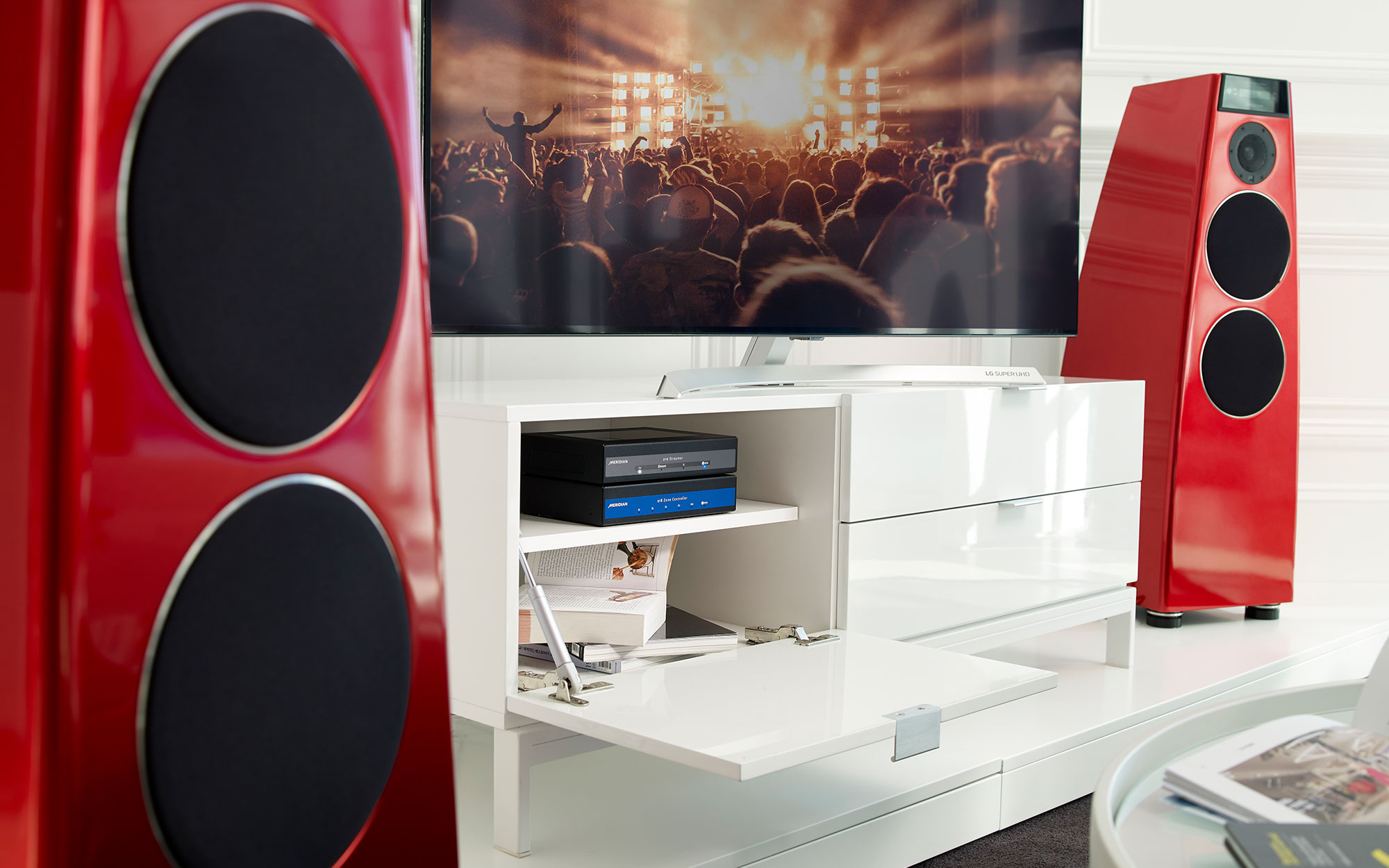
Zone Control
Meridian customers - create an account so you can register your product(s) for your extended warranty.
Dealers, integrators, and installers - create an account to request access to Dealer Resources and/or apply to become a Meridian dealer.

Zone Control
Designed for use in in-room or in-rack, the 218 Zone Controller contains the functionality needed to create a Hi-Res audio zone. Accommodating both local and distributed audio, whether analogue or digital, the Meridian 218 is also an endpoint for Roon, the high-quality streaming service.
With both digital and analogue inputs and outputs, the MQA–enabled Meridian 218 is suitable for a wide range of distributed audio applications from single zone to multi-zone use. Control features including IP and IR, allow this versatile 1U tall product to be easily partnered with any of Meridian’s power amplifiers or DSP loudspeakers.
Zone Control
218
Whether it’s used within a multi-room system or as the central hub in a single zone set-up, whether it’s feeding Meridian DSP loudspeakers or other equipment, the 218 Zone Controller combines flexibility and ease of integration with Meridian’s renowned sound quality.
Meridian Q-Sync deploys Meridian's multiple “First In, First Out” buffering system which minimises jitter, ensuring perfect timing and improved clarity.
Meridian True Link is an encryption method for transferring high-definition digital audio over SPDIF connections. It allows secure movement of digital audio whilst ensuring that the SPDIF clock signal can be transmitted with minimum degradation.
True Time is Meridian's proprietary Apodising Filter that avoids pre-ringing and cleans up the effects of early filters, converting pre-echo to post-echo.

Meridian Digital Precision maximises the signal-to-noise ratio of the digital audio, ensuring the finest details of every song are retained.
Roon Tested devices are profiled by the Roon team to ensure simple setup and effortless daily use.
Seamlessly stream music from the Sonos app to a Meridian system and control the music from anywhere around the home using the Sonos interface. Works in conjunction with the Sonos Port or Sonos Connect products.
Supports full unfold of MQA files to feed its analogue outputs or performs first unfold to feed an MQA renderer product digitally.
The Meridian 200 Series is a collection of high-performance audio zone controllers, theatre controllers and amplifiers, all designed with the Customer Integrator in mind.
Each product is designed to work in isolation or as part of a larger multi-zone audio-visual installation and a compact footprint means they fit perfectly within the rack. With a wide range of audio inputs and outputs, flexible installation options and many of Meridian’s proprietary technologies on board, 200 Series products deliver outstanding performance in many applications.
Here you will find a quick overview of the product highlights and features.
Here you will find a summary of the complete range of Meridian products in one document.
AUDIO INPUTS
One 2-channel digital coaxial S/PDIF input. 44.1kHz to 192kHz sampling and up to 24-bit
One 2-channel Meridian Speakerlink input. 44.1kHz to 192kHz sampling and up to 24-bit
One 2-channel digital optical TOSLINK input. 44.1kHz to 96kHz sampling and up to 24-bit
One 2-channel analogue input
One network input (Ethernet) for connection to a Roon system or an alternative control interface
AUDIO OUTPUTS
2 Speakerlink digital outputs
Single RCA digital output
2-Channel unbalanced analogue output (192kHz DAC)
CONTROL SIGNALS
IP Control: Network socket for use with Meridian IP Control iPad App, other Sooloos control interface and third party control systems
IP Control
IR on 3.5mm jack
DISPLAY
LEDs to indicate source selection and MQA status
DIMENSIONS
HEIGHT: 42mm [1.65in]
WIDTH: 204mm [8.03in]
DEPTH: 150mm [5.91in]
WEIGHT: Standalone: 0.56Kg [1.2lbs]
CONSTRUCTION
1U tall rack kit available with space for two units
Universal mounting bracket
All-aluminium chassis
POWER
High performance power supply: 100V ac 50/60 Hz | 110-120V ac 50/60Hz | 220-240V ac 50/60Hz


The 218 acts as the controller unit for a single room or zone. Control is carried out over IP via the product’s Ethernet network socket, from another Meridian product via SpeakerLink, or from an IR receiver plugged into the unit. The 218 carries analogue and digital inputs and outputs and includes high-quality A/D and D/A conversion. Pathways from all inputs to all outputs are supported. The 218 also acts as a Roon audio end-point and it supports the decoding of MQA files.
Yes. It has inputs and outputs which can pass conventional line-level analogue audio and industry-standard SPDIF digital audio.
Once IP-control is added, the 218 can act as a conventional preamp, providing source selection and volume control. However, it features additional functionality to make it much more flexible than a simple volume and source control.
192kHz, 24 bit.
96kHz, 24 bit.
There is no practicable limit as long as the network is capable of dealing with the traffic derived from multiple devices.
The unit features a high-quality linear PSU and is powered via a 'clover-leaf' mains lead (supplied with the product).
In some systems, video processing causes video to be delayed in relation to the audio. This appears unnatural, adversely affecting the viewing and listening experience. The 218 allows the sound to be delayed, compensating for this effect, to realign the audio with the video.
Some equipment introduces delay to video signals fed through it. Processes such as scaling can cause this. LipSync allows a delay of up to 85 milliseconds to be added to the audio signal to correctly align the sound and picture. However, if the converse is happening and audio is delayed relative to video, i.e. sound is behind the pictures, Lip Sync cannot be used to rectify the problem.
Unwanted delays can be problematic in multi-zone systems which include a mixture of one of more zones using FFA-capable Meridian DSP loudspeakers and one or more zones using analogue loudspeakers. This stems from the fact that FFA introduces a delay to audio through the Meridian loudspeakers. In such systems, if two of the differing types of zone are linked so that they play material simultaneously, the delay on the Meridian loudspeakers may be noticeable if the listener is positioned where they are able to hear sound from more than one zone type. Having the analogue-speaker zones fed by 218s allows LipSync to be used to add delay to align the sound in these zones to the sound from the Meridian loudspeaker zones.
The 218 can be updated using the latest version of the Meridian Device Manager program for PC. Simply run the program on a computer connected to the same network as the 218 and the option to update the firmware will be offered if a newer version is available. This update method also applies to systems with multiple 218s on the network.
This socket is intended to allow the connection of an infra-red receiving “eye”, such as the Meridian G12 Remote Sensor.
One possible explanation is that the 218 needs to have its IR reception enabled. This can be done via the 218 configuration web-page. Set 'IR mode' to 'Controller' and store the settings to the product. Note: if 'IR mode' is set to 'Auto', infra-red reception will be enabled only after the unit has received a 'Clear' command from the remote control via its IR receiver.
Many third-party control systems feature outputs suitable for feeding IR emitter devices (also referred to as IR 'blasters'). The signals sent from these outputs are modulated and previously, Meridian products could not accept them on their IR inputs. However, in February 2020, firmware for the 218 was released which added the ability for the 218 to demodulate such signals.
Firmware versions from 'build 218' onward support this feature. It's just a coincidence that this build number happens to match the product name!
The trigger can be configured to go high (12V) or low (0V) on a source-by-source basis. The socket accepts a mono 3.5 mm jack plug with the tip as the positive connection and screen as ground.
There are several methods for controlling the 218. It can be controlled via its network connection. The Meridian Control app (available from the Apple App Store and Google Play Store) provides access to all relevant functions. Third-party control-systems can control the product via its Automation Protocol. The 218 can also be controlled via infra-red if used in conjunction with an infra-red receiver device such as the Meridian G12. When used in combination with other Meridian products, the 218 can be controlled via its Meridian SpeakerLink connections.
Although the 218 has only one pair of line-level analogue output sockets, the output is capable of driving the inputs of more than one power amplifier in parallel - providing the amplifiers have conventional high-impedance inputs. For example, all eight channels on the Meridian 258 multi-channel amplifier can be fed from one 218 to provide sound for four pairs of speakers.
The 218 has the ability to output digital audio using Meridian's True Link technology (previously known as MHR), a method for transferring digital audio which is proprietary to Meridian products. True Link offers improved sound quality compared to conventional SPDIF digital audio within a Meridian system. However, when a non-Meridian DAC is fed with a True Link, it results in the constant hissing sound as described in the question. All relevant Meridian products have the option is disable True Link (MHR) within their settings. Once True Link is disabled, conventional SPDIF will be output from the device.